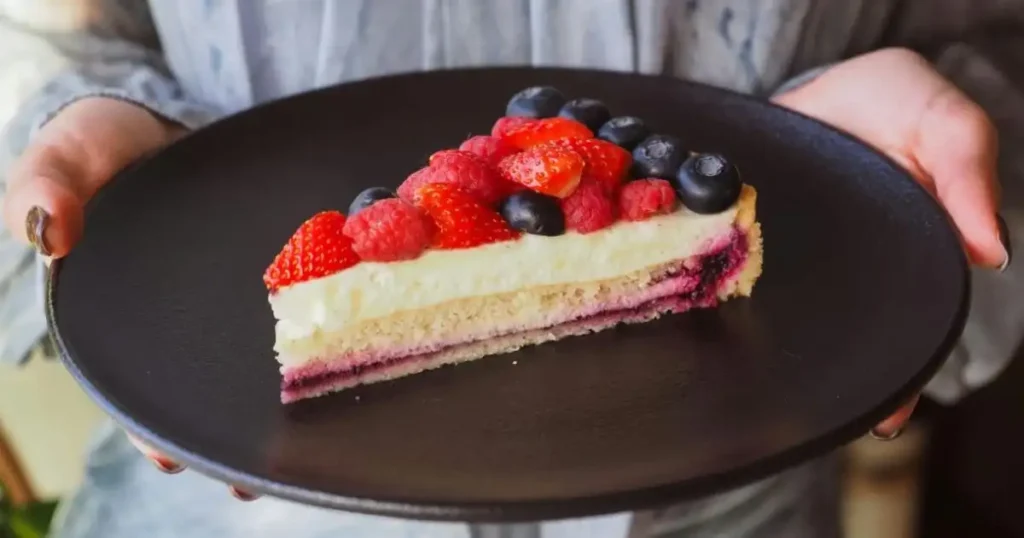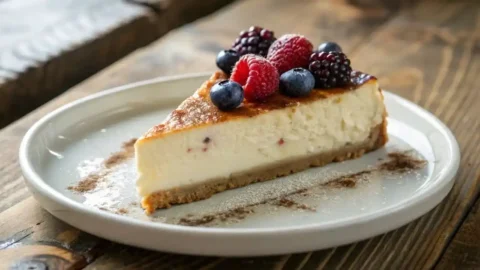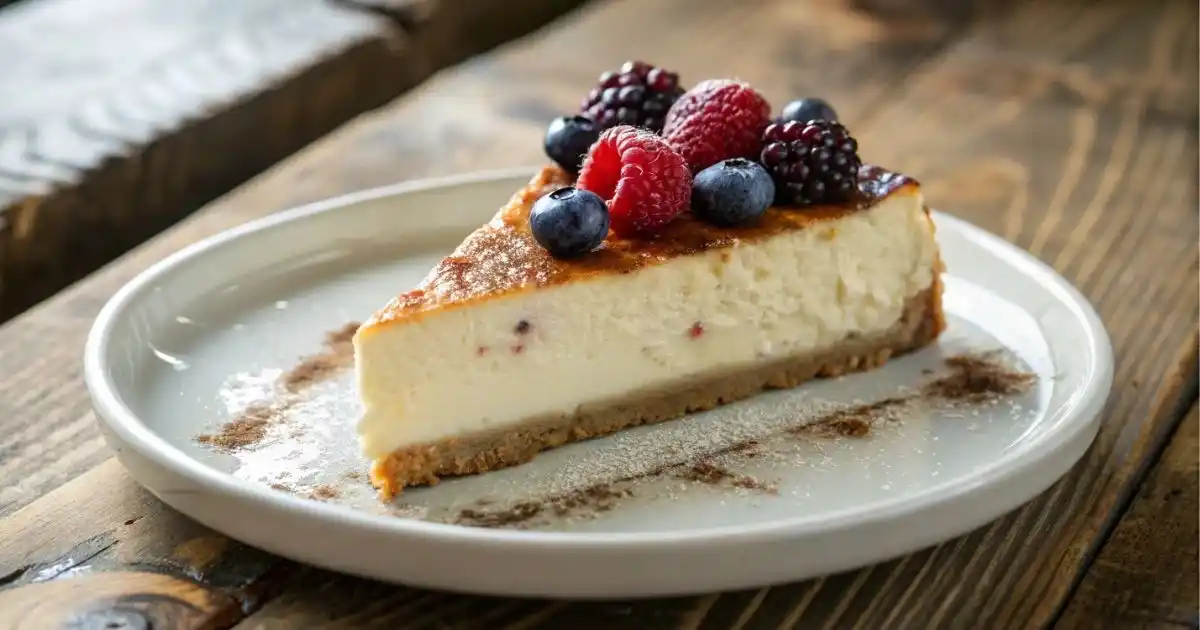The Easy Cottage Cheese Cheesecake Recipe
Introduction
There’s something undeniably comforting about cheesecake. Its creamy texture and sweet flavor evoke memories of family gatherings, special occasions, and perhaps even indulgent late-night snacks. However, traditional cheesecakes can often leave you feeling weighed down, with their rich ingredients and heavy calories. But what if I told you that you can enjoy all the deliciousness of cheesecake without the guilt? Enter cottage cheese cheesecake a light, nutritious twist on the classic dessert that will delight your taste buds while keeping your waistline in check.
Imagine slicing into a perfectly baked cheesecake, the light yet creamy filling melting in your mouth, topped with your favorite fruits or a drizzle of honey. Cottage cheese, a protein-packed ingredient, serves as the star here, offering a wholesome alternative to cream cheese. This article will guide you through the process of making your very own cottage cheese cheesecake, ensuring that you not only satisfy your sweet tooth but also nourish your body.
Table of Contents
What is Cottage Cheese Cheesecake?
Cottage cheese cheesecake is a delightful variation of the traditional cheesecake that replaces the usual heavy cream cheese with cottage cheese. This substitution not only lightens the dessert but also enhances its nutritional profile. Cottage cheese is known for its high protein content and low fat, making it an excellent choice for those looking to indulge without the guilt.
Historically, cheesecakes date back to ancient Greece, where they were considered a source of nourishment and energy. Over the years, variations have emerged across cultures, each bringing its unique flair. The cottage cheese version is particularly popular among health-conscious dessert lovers who seek a lighter alternative without sacrificing flavor or texture.
Why Choose Cottage Cheese for Cheesecake?
Health Benefits
Choosing cottage cheese for your cheesecake offers several health advantages :
High in Protein: Cottage cheese is packed with protein,It can keep you feeling full longer, helping to curb cravings.
Lower in Calories and Fat: Compared to cream cheese, cottage cheese contains fewer calories and less fat, making it a smart choice for a healthier dessert.
Rich in Nutrients: Cottage cheese provides calcium, which is vital for bone health, as well as other essential nutrients like phosphorus and selenium.
Texture and Flavor
You might wonder if cottage cheese can truly deliver that luscious cheesecake texture. The answer is a resounding yes! When blended properly, cottage cheese achieves a smooth consistency that closely resembles traditional cheesecake. Additionally, its mild flavor allows for versatility, letting other ingredients shine while adding a subtle creaminess.
Key Points
Incorporating cottage cheese into your cheesecake not only enhances its nutritional value but also transforms it into a guilt-free dessert. Studies show that diets high in protein can aid in weight management and improve satiety, making this cheesecake a satisfying choice.
Ingredients for Cottage Cheese Cheesecake
Before diving into the baking process, it’s essential to gather all the necessary ingredients. Below is a handy table that outlines what you’ll need to make a delicious cottage cheese cheesecake.
Ingredients
| Ingredient | Quantity |
| Cottage cheese | 2 cups |
| Graham cracker crust | 1 ½ cups |
| Sugar | ¾ cup |
| Eggs | 3 large |
| Vanilla extract | 1 teaspoon |
| Lemon juice | 2 tablespoons |
| Salt | ¼ teaspoon |
| Optional toppings | Fresh fruits, chocolate sauce |
Ingredient Notes
- Cottage Cheese: Use low-fat or fat-free cottage cheese for a lighter version. Make sure to blend it until smooth to avoid any lumps in your cheesecake.
- Graham Cracker Crust: You can make your own crust by crushing graham crackers and mixing them with melted butter and sugar, or you can buy a pre-made crust for convenience.
- Sweeteners: Feel free to adjust the sugar quantity to your taste. You can use sweeteners like honey or maple syrup for a healthier option.
Step-by-Step Instructions
Now that you have all your ingredients ready, let’s walk through the process of making your cottage cheese cheesecake step-by-step. Don’t worry; it’s easier than you might think!
Preparation Steps
- Preheat the Oven: Preheat your oven to (175°C). This ensures that your cheesecake bakes evenly.
- Prepare the Crust: In a bowl, combine 1 ½ cups of crushed graham crackers with ½ cup of melted butter and ¼ cup of sugar. Mix until well combined. Press this mixture firmly into the bottom of a springform pan to form the crust. Make sure it’s evenly spread out for consistent baking.
Make the Filling : In a blender or food processor, add 2 cups of cottage cheese and blend until smooth,In a separate mixing bowl, combine the blended cottage cheese, ¾ cup of sugar, 3 large eggs, 1 teaspoon of vanilla extract, 2 tablespoons of lemon juice, and ¼ teaspoon of salt. Mix until all ingredients are.
Combine and Pour : Pour the cottage cheese mixture over the prepared crust, smoothing the top with a spatula.
Bake : Place the springform pan in the preheated oven and bake for 45-50 minutes, or until the center is set but still slightly jiggly.
Cool : Once baked, remove the cheesecake from the oven and allow it to cool at room temperature. After it’s cooled, refrigerate for at least 4 hours or overnight for best results.
Baking Tips
- Avoid Cracks: To prevent cracks from forming on the surface, avoid overmixing the batter once you add the eggs. Also, try baking your cheesecake in a water bath for added moisture.
- Check for Doneness: The cheesecake is done when the edges are firm and the center has a slight wobble. It will keep setting as it cools down.
Tips for Perfecting Your Cottage Cheese Cheesecake
Creating the perfect cottage cheese cheesecake is an art, and these tips will help you refine your technique:
- Using High-Quality Ingredients: Opt for fresh, high-quality cottage cheese for the best flavor and texture. Check the expiry date to confirm its freshness..
- Blending Techniques: Make sure to blend the cottage cheese until it’s completely smooth. A food processor works wonders for this, ensuring a velvety filling.
- Avoid Overmixing: When adding the eggs to your mixture, mix just until combined. Overmixing can incorporate too much air and lead to cracks during baking.
- Cooling Gradually: After baking, allow your cheesecake to cool slowly in the oven with the door ajar for about an hour before transferring it to the fridge. This gradual cooling helps prevent cracks.
Serving Suggestions
Fresh and Fruity Toppings
- Berry Medley: Add a mix of fresh strawberries, blueberries, and raspberries for a burst of color and flavor.
- Citrus Zest: Sprinkle lemon, lime, or orange zest on top for a refreshing, tangy kick.
- Tropical Twist: Garnish with diced mango, pineapple, or kiwi for an exotic flair.
Rich and Indulgent Toppings
- Chocolate Drizzle: Melt dark, milk, or white chocolate and drizzle it over the cheesecake for an extra layer of indulgence.
- Caramel Sauce: Add a luxurious caramel topping with a pinch of sea salt for a sweet-salty combination.
- Nutty Crunch: Sprinkle crushed nuts like almonds, pecans, or hazelnuts for texture and a nutty flavor.
Classic Pairings
- Whipped Cream: Add a dollop of freshly whipped cream for traditional decadence.
- Powdered Sugar: Dust the top with powdered sugar for a simple, elegant touch.
- Honey Glaze: Drizzle honey for a subtle sweetness and shine.
Creative Variations
- Fruit Compote: Serve with a warm compote made from simmered fruits like cherries, peaches, or plums.
- Spice It Up: Sprinkle ground cinnamon or nutmeg over the cheesecake for a warm, cozy flavor.
- Coffee Lover’s Delight: Add a shot of espresso or coffee syrup for a mocha-inspired topping.
Festive Decorations
- Holiday Garnishes: Add seasonal touches like peppermint crumbs, cranberry sauce, or candied orange slices.
- Edible Flowers: Decorate with edible flowers like violets or pansies for a sophisticated look.


The Easy Cottage Cheese Cheesecake Recipe
Ingredients
Ingredients
For the Filling:
- 2 cups cottage cheese low-fat or fat-free
- ¾ cup sugar
- 3 large eggs
- 1 teaspoon vanilla extract
- 2 tablespoons lemon juice
- ¼ teaspoon salt
For the Crust:
- 1 ½ cups graham crackers crushed
- ½ cup unsalted butter melted
- ¼ cup sugar
Optional Toppings:
- Fresh berries
- Drizzled chocolate or caramel sauce
- Whipped cream
Instructions
- Preheat the Oven: Preheat to 350°F (175°C).
Prepare the Crust:
- Combine graham crackers, melted butter, and sugar in a bowl.
- Press the mixture into the bottom of a springform pan.
Blend the Cottage Cheese:
- Blend cottage cheese in a food processor until smooth.
Make the Filling:
- Mix blended cottage cheese, sugar, eggs, vanilla extract, lemon juice, and salt in a bowl until well combined.
- Assemble: Pour the filling over the crust and smooth the top.
- Bake: Bake for 45-50 minutes until the edges are set and the center jiggles slightly.
Cool and Chill:
- Cool at room temperature for 1 hour.
- Refrigerate for at least 3 hours before serving.
Notes
Nutrition Facts (Per Serving):
- Calories: 210 kcal
- Protein: 12g
- Fat: 9g
- Carbohydrates: 23g
- Fiber: 1g
- Sugar: 17g
- Sodium: 190mg
FAQs
1. Is cottage cheese cheesecake healthier than traditional cheesecake?
Absolutely! Cottage cheese cheesecake is lower in calories and fat compared to traditional cheesecakes made with cream cheese. It also offers a higher protein content, making it a more nutritious option.
2. Can I make this cheesecake gluten-free?
Yes, you can! Simply substitute the graham cracker crust with a gluten-free alternative, such as almond flour or gluten-free cookies, to create a delicious crust.
3. How do I store leftover cottage cheese cheesecake?
Store your cheesecake in the refrigerator, in an airtight container. It should last for about 4-5 days. For longer storage, you can freeze individual slices wrapped in plastic wrap and then foil.
Conclusion
Cottage cheese cheesecake offers a wonderful way to indulge your sweet tooth without the guilt. By using nutritious ingredients, you can enjoy a dessert that is not only delicious but also wholesome. This recipe provides a perfect base for your creativity—experiment with flavors, toppings, and crusts to make it your own.
So, what are you waiting for? Gather your ingredients, roll up your sleeves, and dive into the delightful world of cottage cheese cheesecake. Once you taste this creamy, guilt-free dessert, you’ll wonder why you ever settled for anything less. Don’t forget to share your creations and variations with friends and family, and invite them to enjoy this healthier alternative with you! Happy baking!
Have you given our recipe a try ?
Settat
Beautiful
Last Updated on August 4, 2025 by Janelle
- Healthy Cottage Cheese Pudding Recipe (5 Minutes) - December 20, 2025
- Strawberry Crunch Cheesecake: Easy Recipe & Tips - December 6, 2025
- The Ultimate Sopapilla Cheesecake Recipe (Churro Cheesecake Bars) - November 22, 2025

